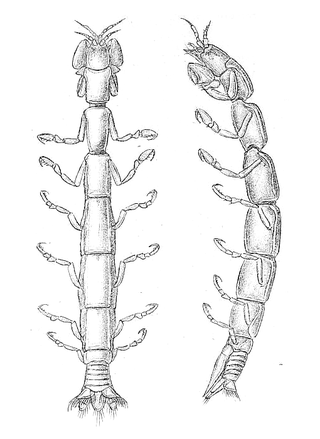
Isopoda is an order of crustaceans that includes woodlice and their relatives. Isopods live in the sea, in fresh water, or on land. All have rigid, segmented exoskeletons, two pairs of antennae, seven pairs of jointed limbs on the thorax, and five pairs of branching appendages on the abdomen that are used in respiration. Females brood their young in a pouch under their thorax.

Sphaeromatidae is a family of isopods, often encountered on rocky shores and in shelf waters in temperate zones. The family includes almost 100 genera and 619 known marine species. Within these genera, there are groups that share distinctive morphologies; further research may reclassify these genus-groups as separate families.
Iais is a genus of isopod crustaceans. Iais species are found in association with larger isopods of the family Sphaeromatidae, usually on the ventral surface of the larger animal, between the pereiopods and on the pleopods. They are native to Australasia and South America, although Iais californica and its host Sphaeroma quoyanum have invaded California, and I. californica was first described from Sausalito, California. Nine species are recognised:

The Idoteidae are a family of isopod crustaceans. It includes these genera:

The Cirolanidae are a family of isopod crustaceans, including these genera:

The Leptanthuridae are a family of isopod crustaceans, containing the following genera:
The Cabiropidae are a family of isopod crustaceans in the suborder Cymothoida. The original description was made by Giard and Bonnier in 1887. Members of the family are hyperparasites of other parasitic isopods in the order and some are parasites on other free-living isopods.

The Arcturidae are a family of marine isopod crustaceans in the suborder Valvifera. Members of the family resemble woodlice and are found globally in cooler areas in shallow seas.
Dynoides is a genus of isopod crustaceans in the family Sphaeromatidae, containing the following species:
Exosphaeroma is a genus of marine isopod of the family Sphaeromatidae. This genus is found in shallow ocean waters worldwide. It is notable for being one of the few genera of sphaeromatid to be found in the southern reaches of the Southern Ocean. The greatest diversity of Exosphaeroma occurs in the Southern Hemisphere.
Dynoides amblysinus is a species of isopod in the family Sphaeromatidae.
Dynoides spinipodus is a species of isopod in the family Sphaeromatidae.
Dynoides brevispina is a species of isopod in the family Sphaeromatidae.
Dynoides longisinus is a species of isopod in the family Sphaeromatidae.
Dynoides indicus is a species of isopod in the family Sphaeromatidae. It can be found in the water near Sri Lanka.
Dynoides daguilarensis is a species of isopod in the family Sphaeromatidae.
Dynoides serratisinus is a species of isopod in the family Sphaeromatidae. It is found in the Indian Ocean.
Dynoides brevicornis is a species of isopod in the family Sphaeromatidae.
Laureola is a genus of woodlice, a land crustacean isopod of the family Armadillidae.




